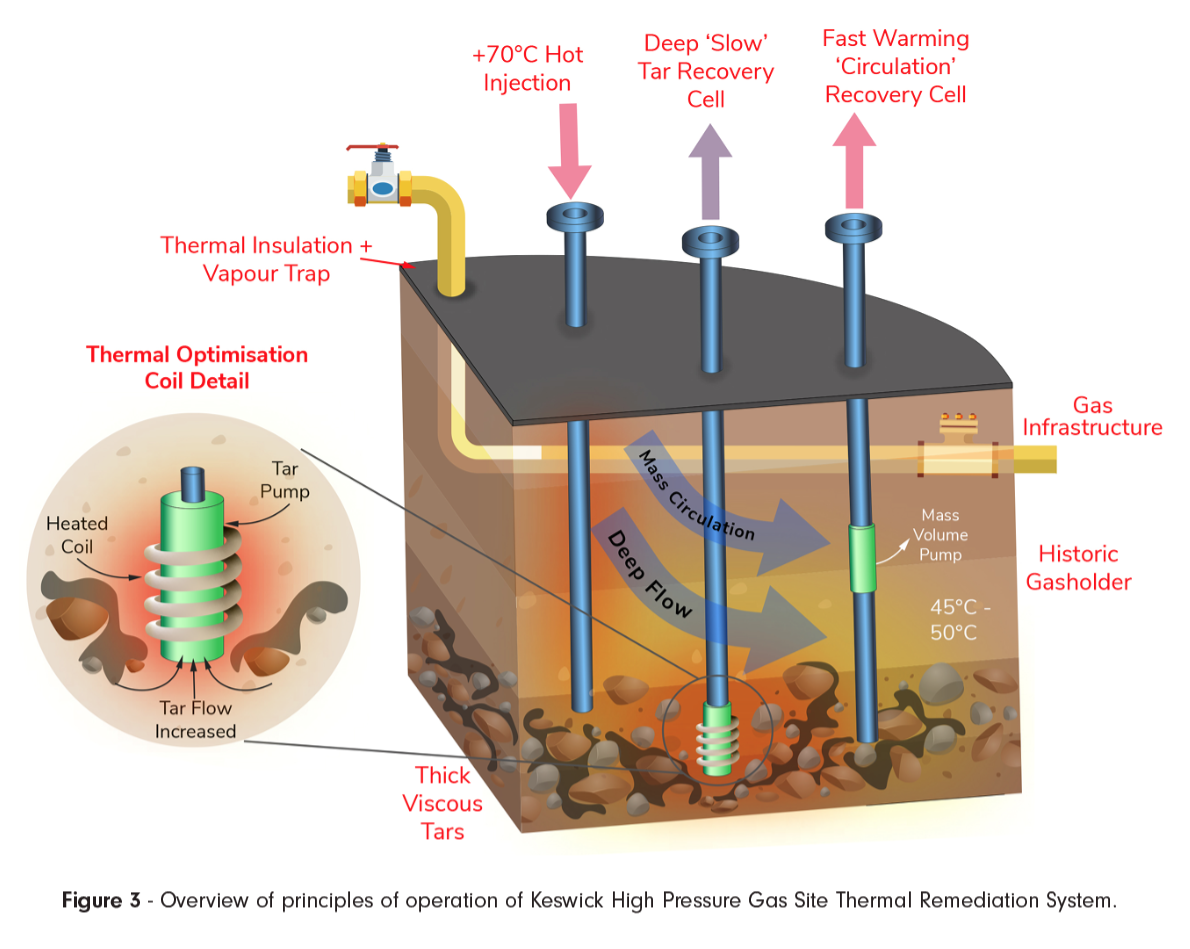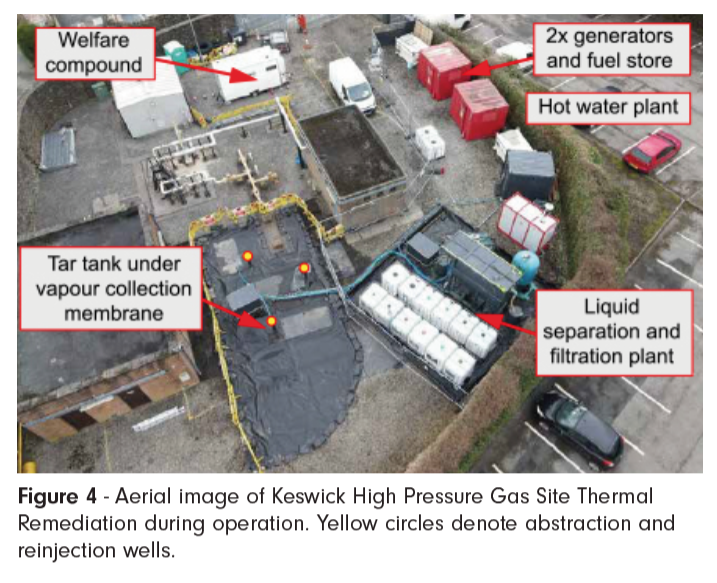Hubble, Bubble Tar from Rubble
Keswick High Pressure Gas Site Thermal Remediation
Brownfield Awards: Winner of Best Remediation of a Smaller Site
NGN own and operate a natural gas pressure reduction station in the centre of Keswick, Cumbria in the Lake District National Park (‘the Site’), a UNESCO World Heritage Site. The Site features a dense array of natural gas distribution infrastructure, giving the Site a critical regional role providing gas to over 3000 properties. The Site is prominently located in a dense urban environment within this popular tourist town, with residential and commercial properties within 10m to the north and east and a public car park to the south and west. The River Greta (Main River) flows southeast to northwest approximately 15m from the site.
The Site was formerly part of Keswick Gasworks, which operated from 1899 until c.1968 and extended across the land to the south and west, now operated as a Local Authority owned car park. Several town gas production structures were formerly located on Site, including a distinctive semi-circular tar well (tank), identified to be c. 15m diameter (covering c. 65m2) and 2.3m deep, extending underneath the high pressure gas infrastructure and within 3m of live gas infrastructure in all directions. As shown on Figure 1.



The CSM identified that the DNAPL present within the tank base was substantially contained and hydraulically isolated from surrounding groundwater in the superficial Secondary A Aquifer, with no further significant sources of contamination identified beneath the Site. Whilst being contained under current site conditions, the contamination within the tar tank posed a potentially significant risk to environmental receptors (including surrounding groundwater within the superficial Secondary A Aquifer and the nearby River Greta), which could increase over time in the event of degradation of the tar tank structure.
In 2018 NGN commissioned Sweco to assess the potential to reduce the quantity of DNAPL in the tar tank as far as possible and thereby deliver permanent environmental betterment. A structured, multi-factored remediation options appraisal (ROA) was undertaken by Sweco to identify potentially suitable remediation methods which could meet the remediation objectives under the known severe site constraints as shown in Figure 2.
The ROA identified that mechanical pumping alone was unlikely to recover significant DNAPL. The most technically feasible option identified was thermal circulation pump and treat to increase the mobility and rate of recovery of the DNAPL and increase the degradation of any residual dissolved phase contamination.
Treatment and Implementation
NGN appointed Sweco and their specialist remediation sub-contractor Geo² to complete a remediation feasibility assessment, ensuring delivery of the best feasible outcome. The field and bench testing indicated that at temperatures ranging between 30°C and 40°C the DNAPL would be amenable to thermally enhanced pumped recovery. Pumping tests also identified suitable tank water abstraction and injection rates and confirmed hydraulic connectivity within the tank to enable remediation.
Feasibility assessment by Sweco and Geo² informed the design of a bespoke remediation system. The challenging constraints of the site required a radical innovative solution; operation of a thermally enhanced treatment on a live high pressure gas facility, as summarised in Figures 3 and 4.
To achieve mobile, recoverable DNAPL, the system was designed to heat the entire tar tank to c.40-50°C. This was achieved by establishing a closed loop, circulation system to facilitate and distribute heat transfer within the heterogenous tank fill. Using 150mm diameter wells, recovered tank waters were heated to c.60-70°C using a 100kW boiler prior to re-injection under low pressure into the former tar tank.

This hot water current, emanating from the injection well, developed hydraulic flow cells with heat exchange through direct water heating, conduction and convection within the substrate and environment.
Parallel to this heating, a dual circulation system was established through two primary abstraction processes, calibrated against the rate of injection:
- The operation of base loading DNAPL recovery pumps set at the tank base. These pumps targeted the highly mobile, temporarily low viscosity DNAPL which had mobilised along the concrete tank base, enabling recovery for separation and storage prior to disposal; and
- A high volume ‘mid-well’ abstraction pump, which maintained the water balance within the tank, essential to preserving structural integrity of the tank and minimising settlement of the tank fill materials to avoid potential damage to surrounding gas infrastructure. This recovered both mobilised transitory NAPLs and dissolved phase contaminants.
Prior to heating and recirculation, abstracted water was treated to settle sediments, recover cooling NAPLs within a series of separators and storage vessels, and finally de-contaminated using Granular Activated Carbon (GAC) filtration in readiness for a fresh circulation.
To maximise the efficiency and speed of the operation, the system was computer controlled, with sensor driven feedback and telemetry to permit safe optimised 24-hour operation, water level control and environmental compliance.

Effective public/stakeholder engagement
The project environmental aspects and impacts assessment identified the potential for adverse impacts on local stakeholders in association with the remediation works, most notably additional noise from the system generator, odours/vapours from recovered DNAPL, and additional traffic movements. A proactive approach to stakeholder engagement was undertaken throughout the project commencing with early engagement with the NGN Maintenance and Safety Teams, Environment Agency, Local Authority and Lake District National Park Planning Authority in preparation for the works. Potential negative impacts were designed out during the project design phase, including:
- Plant selection and location was carefully designed, working around the explosive zoned areas and the highly restrictive live gas infrastructure, a single point of failure for supply to the whole town.
- Use of a super silent generator and informed generator positioning on site to minimise noise impacts. A detailed pre-works noise modelling assessment was prepared for the Local Authority confirming no significant noise impact, which was confirmed by check monitoring during works.
- Encapsulation of the entire tar tank surface using a membrane under negative pressure to capture any vapours for treatment, with check monitoring along the site boundaries throughout the works.
Proactive engagement with the Local Authority, County Council Highways team, Keswick Town Council, local Police and local businesses during site mobilisation and demobilisation phases which along with careful logistics planning ensured disruption was kept to a minimum, in particular in the adjacent popular public car park.
NGN completed a pre-works letter drop to inform local residents about the scheme and provide contact details for the project team. This enabled one local resident to proactively contact NGN at the end of the project to state:
" Thank you for sending such a wonderful bunch of men. They were very polite, kept me informed and couldn’t do enough to help me "
Real environmental/ecomonic/social benefit
This project has delivered permanent environmental betterment by the removal of hazardous substances from within an aged in-ground structure which had significant potential to impact the quality of surrounding controlled waters (Secondary A Aquifer and River Greta). A total of 7.5m³ of NAPL and contaminated waters were removed from site during the works, with the remainder of the tank waters circulated c.350 times through the treatment plant resulting in the disposal of c.2m³ of GAC grossly impacted with mobile hydrocarbons.
Project environmental monitoring two weeks after completion of the works identified that:
- the thickness of DNAPL in the monitoring wells inside the tank had reduced from 0.5m pre-works to smearing only, with no measurable DNAPL; and
- dissolved concentrations of BTEX, TPH >C5-C35 (aliphatics and aromatics), total cyanide and total phenols in tank waters had reduced by 87%, 94%, 95% and 98% respectively compared to pre-works levels.
The regionally important site gas infrastructure continued to operate throughout the project without hindrance. In addition, no significant impacts were felt by surrounding stakeholders, with several complimenting the project team for their attitudes and behaviours.
The complex setting of this site required design of an innovative remedial solution from the ground up. Successful implementation maximised DNAPL recovery in a short programme duration, with best practice delivery recovering all observable mobile DNAPL and substantially reducing dissolved phase contamination thereby permanently reducing the risk profile of the site to ‘low’ at c.50% of the cost of conventional remediation techniques.

